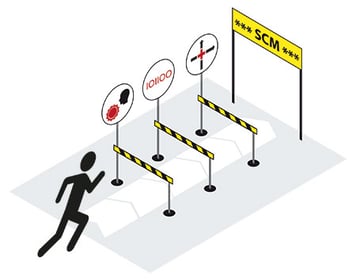Getting Over the Hump: 3 Architectural Hurdles in Today’s Supply Chain
Nick Ostdick - August 09, 2016

 Think of some of the world’s grandest structures. The Great Wall of China. London’s Big Ben. The Eiffel Tower. What do they have in common? Each of these man made marvels consists of a unique architectural makeup with its own set of complexities, quirks, innovations, and characteristics. Odd as it may sound, the same is true of today’s global, automotive supply chain - a system which contains its own unique internal architecture that when mapped and utilized properly results in an efficient, cost-effective mode of operation across each touch of a manufacturer’s entire value stream.
Think of some of the world’s grandest structures. The Great Wall of China. London’s Big Ben. The Eiffel Tower. What do they have in common? Each of these man made marvels consists of a unique architectural makeup with its own set of complexities, quirks, innovations, and characteristics. Odd as it may sound, the same is true of today’s global, automotive supply chain - a system which contains its own unique internal architecture that when mapped and utilized properly results in an efficient, cost-effective mode of operation across each touch of a manufacturer’s entire value stream.
The architectural challenges for Big Ben or The Great Wall were relegated to materials, availability of labor, environmental and weather conditions, and more. While much of the same could be said for the architectural challenges in the supply chain - availability of materials, streamlined processes, and resources certainly play a role - the challenges companies face in a modern supply network are more vast and complex and require integrated, holistic software solutions and strategies in order to achieve the end goal: a transparent, agile supply stream capable of weathering bottlenecks and disruptions.
With this mind, let’s look at 3 common architectural hurdles in today’s supply chain, and why companies need to overcome these hurdles to remain viable and competitive in a global, expanding industry.
Merging the Planning and Execution Levels
The misconception still exists that planning and execution in the supply chain are disparate acts or ideas with little bearing on each other. While it’s true both do exist in somewhat separate spheres, there is indeed overlap between them - imagine a ven diagram with planning on one side, execution on the other, and a small bubble between where these processes blur together. Understanding how planning and execution function independently will help deepen the appreciation for the moments when they work in tandem.
First, it’s useful to think of planning in a more holistic sense - a large scheme strategy manufacturers create to manage elements of the supply chain beyond simple day-to-day operations. Some of these functions and strategies may include concerns like large-scale management of production sites or facilities, yard and dock management, inventory optimization and management, and freight and warehouse strategy. Decisions regarding the management of these elements usually takes place far removed from daily operations due to necessity - if these macro decisions were not made in advance, manufacturers would lack a platform on which to operate - and often lack the responsiveness and agility to deal with the dynamics of the execution process.
Execution, on the other hand, is more of a granular way of addressing production and supply logistics. More concerned daily operations, execution concerns can center on the movement of products and parts within one production facility. Logistical elements such as Plan for Every Part and Every Part Every Interval are key drivers in the execution as they provide manufacturers with the ability to examine the supply network on a more micro level and engage in faster decision-making to avoid bottlenecks, breakdowns, or other disruptions.
More or less, planning is the long game and execution is the short game, and it’s when the two are integrated at appropriate levels can manufacturers find the right balance between long-term, macro decision-making and short-term micro decision-making. Merging these two levels of thinking will ultimately help dismantle cross-functional silos, create a more communicative and collaborative environment, and foster a more lean, efficient supply stream.
Lack of Digitalization
The lack of digitalization within today’s supply chain landscape is perhaps one of the more varied and troubling hurdles manufacturers must face, if for no other reason than the sheer proliferation of digital technology and the need for OEMs to function enhanced responsiveness and agility. Partly due to the complications that emerge from merging the planning and execution levels, companies that lack digitization strategies suffer from lost time and resources in consolidating information, data, and knowledge from the planning level into a centralized, digital hub where that data can be accessed and acted on.
This in turn creates functional silos between various planning and production entities, which can severely hamper communication and collaboration at crucial touch points across the value chain. In addition, the lack of digitization can also play havoc with a company’s ability to utilize data from event management instances to help reshape production or supply strategies as necessary - whether based on customer demand or other rules and restraints.
Without the ability to access in real-time vital information on the current status of the supply network at-large, as well as its smaller component parts, manufacturers lack the transparency and visibility needed to leverage cost-effective and productivity-based decisions to ultimately fill orders on-time and within previously established delivery windows.
Lack of Integration
As we discussed in a previous blog, engendering a supply chain with true end-to-end (E2E) visibility demands a hybrid of horizontal and vertical integration we coined as ‘vertizontal’ - combining the best elements of both to foster a truly visible, agile supply stream. This kind of integration requires intelligent software on multiple fronts, including Plan for Every Part (PFEP), optimized BOM and inventory management solutions, and a comprehensive reinvention of the metrics used to measure success. On-time deliverability and the cost of delivering parts and products is no longer the endgame, and companies must evaluate all points of the value stream from facility management to transportation to personnel and resources in order to operate a truly lean supply network.
Why is this an architectural hurdle?
As we pointed out in our original post, the idea of horizontal or vertical integration is less of a shift in tactic or strategy and more of a change in perception and how companies view supply chain management. Because combining these two modes of integration requires a holistic reinvention of how supply streams operate, fostering this hybridization can be a tough hill to climb for companies, though an important hill nevertheless in working toward more visible manufacturing and supply practices.
LATEST POSTS
- Understand Circular Economy in The Manufacturing Industry
- How Can Industry 4.0 IT Integration Be Achieved Smoothly?
- The Significance of Order Sequencing in Discrete Manufacturing
- How to improve your Supply Chain Management: The Power of Control Towers
- Optimizing Human Resource Scheduling in Manufacturing: A Technological Approach



